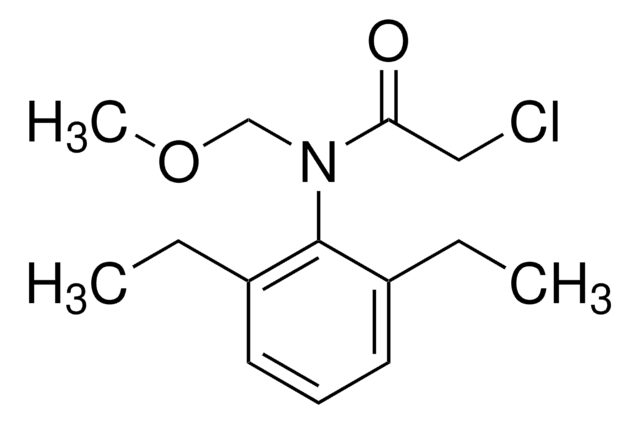49085
Atrazine
analytical standard
Sinónimos:
2-Chloro-4-ethylamino-6-isopropylamino-1,3,5-triazine
About This Item
Productos recomendados
grade
analytical standard
Quality Level
CofA
current certificate can be downloaded
packaging
ampule of 100 mg
technique(s)
HPLC: suitable
gas chromatography (GC): suitable
application(s)
agriculture
environmental
format
neat
storage temp.
2-30°C
SMILES string
CCNc1nc(Cl)nc(NC(C)C)n1
InChI
1S/C8H14ClN5/c1-4-10-7-12-6(9)13-8(14-7)11-5(2)3/h5H,4H2,1-3H3,(H2,10,11,12,13,14)
InChI key
MXWJVTOOROXGIU-UHFFFAOYSA-N
Gene Information
mouse ... Esr1(13982)
¿Está buscando productos similares? Visita Guía de comparación de productos
Categorías relacionadas
General description
Application
signalword
Warning
hcodes
Hazard Classifications
Aquatic Acute 1 - Aquatic Chronic 1 - Skin Sens. 1 - STOT RE 2
Storage Class
11 - Combustible Solids
wgk_germany
WGK 3
ppe
dust mask type N95 (US), Eyeshields, Faceshields, Gloves
Elija entre una de las versiones más recientes:
¿Ya tiene este producto?
Encuentre la documentación para los productos que ha comprado recientemente en la Biblioteca de documentos.
Los clientes también vieron
Protocolos
HPLC Analysis of Urea, Carbamate, Triazine, Aniline Pesticides on Discovery® C18
Separation of Atrazine-desethyl; Metoxuron; Hexazinone; Simazine; Cyanazine; Methabenzthiazuron; Atrazine; Monolinuron; Diuron; Isoproturon; Metobromuron; Metazachlor; Sebuthylazin; Linuron; Metolachlor
Nuestro equipo de científicos tiene experiencia en todas las áreas de investigación: Ciencias de la vida, Ciencia de los materiales, Síntesis química, Cromatografía, Analítica y muchas otras.
Póngase en contacto con el Servicio técnico



